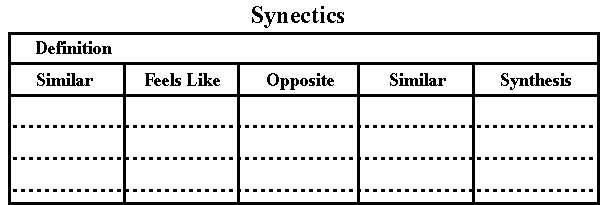EDTE 233
Teaching Problem-Solving with Educational Technology.
Synectics
Background Information:
Synectics (Gordon, 1961) provides an approach to creative thinking that depends on looking at, what appears on the surface as, unrelated phenomenon and drawing relevant connections. Its main tools, analogies or metaphors. The approach, often used in group work, can help students develop creative responses to problem solving, to retain new information, to assist in generating writing, and to explore social and disciplinary problems. It helps users break existing minds sets and internalize abstract concepts. Synectics works well with all ages as well as those who withdraw from traditional methods (Couch, 1993).
For this assignment we will use the synectics table to help guide an online brainstorming session.
Read through the following 7 steps and look over the model provided below the table.
- Define the word(s): Use a dictionary or other standard source to define each word, concept, or theme.
- Create direct analogies: What words have the same or similar meaning? (use a Thesaurus or book of synonyms)
- Describe personal analogies: What would it feel like to have the characteristics or traits of…? (describe emotions and physical attributes)
- Identify compressed conflicts: What words have the opposite meaning or characteristics? (use a book of antonyms)
- Create a new direct analogy: What words have the same or similar meaning?
- Synthesis: Look at all four lists and find key words or phrases, expand on those to generate more. Finally, focus on a theme that may incorporate several elements based on the final list.
- Write: Continue with the writing process.

Model
The concept is the idea to be brainstormed
Examples: First Day of School, Mondays, Snow, Sports
Let's brainstorm the concept, Snow
white
cold
fresh
dry
wet
fluffy
clean
Analogy
Compare "snow" to a tool, a bird, a plant, a tree, a fire, a dream.
Let's choose, a plant
Snow is like a
rose, apple tree, cactus, weed, algae, daffodil
Metaphor
(Choose one from the list above)
Let's choose, a rose
Create metaphors
I beautify
I cause to bleed
I puncture
Compressed Conflict
Create two seemingly dissimilar ideas
fluffy thorn
dry puncture
punctured rose
Metaphor
Choose a compressed conflict
Create more metaphors
Write rough drafts
Continue with the writing process using the integrated process.
Each team will be assigned a number. Enter your contribution to the group brainstorm on your team's numbered line/boxes. Decide who will be partner a and partner b so that you do not overwrite your partner's, or any one else's work!
Together with your partner, go to http://docs.google.com/Doc?id=df4z6t4c_12pp85nj
and follow the directions. Be sure to login to your Google Docs account so you can edit the page!
References
Couch, Richard (1993). Synectics and Imagery: Developing Creative Thinking Through Images. In: Art, Science & Visual Literacy: Selected Readings from the Annual Conference of the International Visual Literacy Association (24th, Pittsburgh, PA. September 30 - October 4, 1992). (ERIC Document Reproduction Service No. ED 363 330)
Gordon, W.J.J. (1961). Synectics. New York: Harper & Row.
Retrieved from http://www.csus.edu/indiv/m/mcvickerb/sj_synectics.html
Instructor
Joyce Dibble
Students will need an e-mail account and computer access to the Web. All Sacramento State students enrolled in one or more units can create a SacLink account for e-mail. Although a home computer with Internet access running Microsoft Internet Explorer, Mozilla Firefox or Netscape Navigator would be beneficial, students can access the Internet from one of the campus student labs. Check out System Check and Computer Hardware Recommendations for more information about equipment.
Last updated: 10/25/2007
